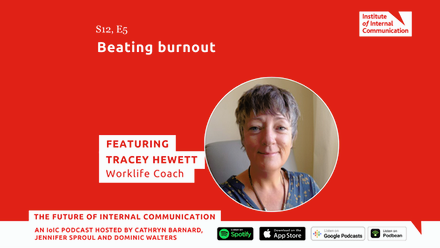Quiet cracking: how internal communicators can help leaders hear what isn’t said
A new emotional undercurrent is surfacing in today’s workplaces. It is not loud, not visible, not tracked by dashboards or solved by perks. It’s called quiet cracking; the silent, internal stress experienced by employees who still deliver, but are emotionally slipping through the cracks.
Coined earlier this year, the term describes something more elusive than burnout and more concerning than disengagement. Employees keep showing up, but trust, connection and motivation are quietly fading.
This hidden pressure often forms in hybrid environments, where digital productivity masks emotional withdrawal.
As internal communication professionals, we often feel this pressure too quietly, bearing the load of emotional labour while being tasked with keeping others connected.
However, our role puts us in a unique position: to act as early-warning systems and trusted cultural architects. We can spot weak signals before teams break and help leaders course-correct with empathy and clarity.
Crucially, we can guide leaders in how to see what might not be said.
This responsibility doesn’t rest solely with the C-suite. Line and middle managers have more frequent proximity to morale and mood. By supporting these managers and working in step with HR and engagement teams, IC can help prevent the spread of silent strain.
It starts by seeing communication not as output, but as emotional infrastructure. When we help leaders speak with employees, not just to them, we shift from broadcasting to bonding.
Here are ten integrated ways internal comms professionals can support leaders in spotting, addressing and preventing quiet cracking, before a hairline fracture becomes a break.
-
Encourage leaders to treat feedback as a relationship, not a transaction.
Rather than viewing feedback as a one-off event, help leaders approach it as an ongoing loop. Advocacy and trust grow when employees see that their voices spark visible action.
Simple rituals like “We asked, you said, we did” updates or team retrospectives can show that feedback leads to real outcomes. Don’t let data collection become performative; close the loop often and in the voice of the people.
-
Equip leaders and managers with emotional fluency, not just talking points.
Managers don’t need to be therapists, but they do need to spot emotional strain and respond with empathy. Offer training on active listening, inclusive language and narrative-led communication. Encourage peer coaching and reflective feedback from their teams.
Leaders who model emotional openness create safe spaces before issues escalate.
-
Build forums where honesty doesn’t feel like a risk.
Top-down messaging won’t surface quiet cracking on its own. Create space for “ask me anything” sessions, no-agenda meetings or psychological check-ins. Coach leaders to welcome discomfort without defensiveness and gather themes – not names – to protect candour.
Make it clear that honest feedback shapes priorities, not performance reviews.
-
Help leaders speak confidently, even when clarity is lacking,
Silence in times of change can quickly breed anxiety. When strategies shift or crises emerge, employees need leaders who can acknowledge uncertainty without losing direction. Help them frame ambiguity with truth and humanity. Use metaphor, story and visual language to make the unknown feel less destabilising.
-
Encourage leaders to make rest visible, not aspirational.
Cultures that glorify endurance feed quiet cracking. Support leaders in sharing their mental resets and celebrating teams that prioritise balance. Treat wellbeing as essential, not earned. Showcase where boundaries are respected and recovery is seen as strength, not indulgence.
-
Advocate for sensing, not just surveying.
Traditional engagement surveys may miss subtle disconnection. Encourage live sensing methods like pulse checks, mood mapping or listening weeks. But sensing is only powerful when followed by response; insight without action breeds cynicism.
Collaborate with HR and analytics teams to track emotional health as seriously as operational KPIs.
-
Reposition growth as a sign of belief, not just reward.
Quiet cracking often starts where development stops. Partner with HR to communicate clear growth paths, internal mobility and accessible learning.
Personalise the messaging so it doesn’t feel like progression is reserved for top performers. Help leaders connect development with trust in someone’s future.
-
Translate company values into daily behaviour, not wall posters.
Values protect against quiet cracking only when they’re lived. Support managers in embedding values into rituals, team check-ins, one-on-ones and recognition moments.
Show how vulnerability, candour and accountability reinforce values in action. Reconnect values to their origin stories, not just corporate branding.
-
Measure what matters emotionally, not just operationally.
Quiet cracking hides behind strong KPIs. Help leaders see that output doesn’t always equal wellbeing. Co-create dashboards that include qualitative insights, communication effectiveness and team sentiment.
Use narrative data alongside numbers to show how people are feeling, not just how they’re performing.
-
Form a coalition of care with HR and wellbeing teams.
You don’t need to tackle this alone. Align IC with HR, ED&I and engagement leads to ensure consistency in tone, timing and care. When people and comms move in sync, support becomes more than a message, it becomes a system. Joint ownership avoids blind spots, mixed signals and duplicated effort.
Quiet cracks speak volumes
Quiet cracking is not a buzzword; it is a cultural clue. It warns us that emotional alignment is faltering and that performance masks pain.
However, it is also an invitation for leaders, managers and communicators to co-create workplaces where people feel seen, heard and safe.
By helping leaders connect with clarity and care, internal communications professionals can stop a crack from becoming a break.






